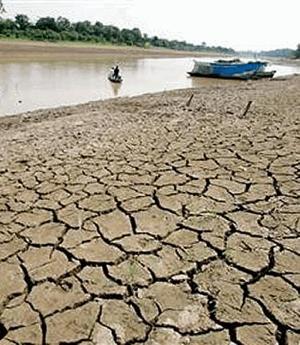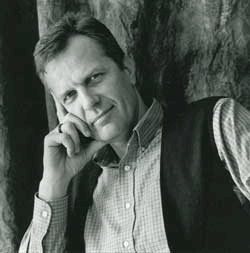Drought in the Amazon
Air Date: Week of December 10, 2010
 |
Rivers in the Amazon are drying up as the world's largest rainforest experiences increasingly frequent droughts. Dan Nepstad, Director of International Programs at the Amazon Environmental Research Institute, tells host Bruce Gellerman that such droughts are consistent with predictions for climate change.
Transcript
CURWOOD: It’s Living on Earth, I’m Steve Curwood.
GELLERMAN: And I’m Bruce Gellerman at the United Nations Climate talks in Cancun Mexico - where extreme weather around the world this year has given urgency to the negotiations. In Pakistan, an epic monsoon left a fifth of the country underwater. In Russia, a searing heat wave ignited massive forest fires, and in Brazil’s Amazon basin a record drought dried up many of the rivers that sustain the biologically rich rainforest. Tropical ecologist Dan Nepstad is Director of International Programs at IPAM, the Amazon Environmental Research Institute.
NEPSTAD: It’s about as bad as we’ve seen. I’ve been working in the Amazon for about 25 years now, and I haven’t seen anything like it. We thought we had the worst drought of the century in 2005, and this one is worse.

Dan Nepstad is Director of International Programs at the Amazon Environmental Research Institute. (Photo: Dan Nepstad)
GELLERMAN: That drought in 2005 was called a once-in-a-century drought. That’s five years ago.
NEPSTAD: I know. And, there was a drought in 2007 that didn’t even capture any immediate attention, it wasn’t even worth it because drought is really becoming part of the fabric of the Amazon. And that affects everything from when you plant your crops to whether or not forests are going to catch fire or not, to whether or not you can use your canoe or boat to get to school or the market or the nearest big city.
GELLERMAN: So what do you think is causing this drought?
NEPSTAD: You know, statistically, it’s just very hard to take an individual event like this mega-drought of the Amazon, and say that it is a direct cause of climate change. But, with both this and the 2005 and the 2007 drought, they’re all consistent with the scenario of increasing accumulation of greenhouse gasses in the atmosphere.
GELLERMAN: How does the drought affect the rainforest? And then I guess, how does the rainforest then affect the drought?

Drought in northern Brazil had dried up some tributaries of the Amazon River, isolating rural communities. (Earth Week)
NEPSTAD: The forest actually makes the rain in the Amazon. By the end of the dry season, a lot of Amazon trees are sucking water from the soil- it could be 60 feet beneath the ground surface. So, they’re going way down deep to get that water, so that they can keep their green lush canopy, even though they’ve been deprived of water for a few months. And, that water going into the atmosphere makes the clouds that makes the rain. Similarly, the rain coming down, if it weren’t for that rain, if those dry seasons got longer on a permanent basis, then that forest would cease to be. It would be replaced by grassy vegetations, savannahs, woodlands and scrub that would burn periodically, and that would look very different and have far fewer species.
GELLERMAN: These droughts are drying up the rivers. The rivers also drive hydroelectric dams. And, Brazil has a very ambitious program to build, what, 50,60 dams in the Amazon? How would these droughts affect them?
NEPSTAD: If you get droughts coming in on top of deforestation, you get much less prediction of energy. And, that’s the scenario that really isn’t taken into account when the big planners of the hydroelectric dams plan these projects. There are many other dams planned for the Madeira, which also has a great vulnerability to climate change. So, if rainfall breaks down and is inhibited, the big energy supplies that are counted on from these dams, will be suppressed during the dry season.
GELLERMAN: Dan Nepstad is with the Amazon Environmental Research Institute.
Links
Living on Earth wants to hear from you!
Living on Earth
62 Calef Highway, Suite 212
Lee, NH 03861
Telephone: 617-287-4121
E-mail: comments@loe.org
Newsletter [Click here]
Donate to Living on Earth!
Living on Earth is an independent media program and relies entirely on contributions from listeners and institutions supporting public service. Please donate now to preserve an independent environmental voice.
NewsletterLiving on Earth offers a weekly delivery of the show's rundown to your mailbox. Sign up for our newsletter today!
 Sailors For The Sea: Be the change you want to sea.
Sailors For The Sea: Be the change you want to sea.
 The Grantham Foundation for the Protection of the Environment: Committed to protecting and improving the health of the global environment.
The Grantham Foundation for the Protection of the Environment: Committed to protecting and improving the health of the global environment.
 Contribute to Living on Earth and receive, as our gift to you, an archival print of one of Mark Seth Lender's extraordinary wildlife photographs. Follow the link to see Mark's current collection of photographs.
Contribute to Living on Earth and receive, as our gift to you, an archival print of one of Mark Seth Lender's extraordinary wildlife photographs. Follow the link to see Mark's current collection of photographs.
 Buy a signed copy of Mark Seth Lender's book Smeagull the Seagull & support Living on Earth
Buy a signed copy of Mark Seth Lender's book Smeagull the Seagull & support Living on Earth

